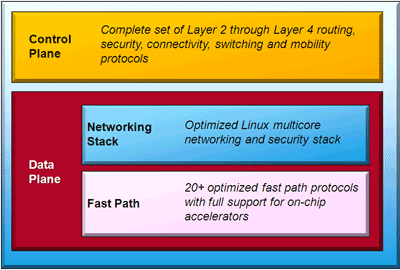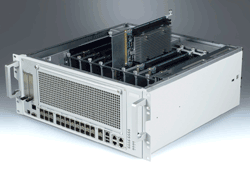Cutting network power with optimized packet software
Standard networking stacks can inhibitpacket processing efficiency
BY CHARLIE ASHTON
Vice President of Marketing
6WIND
www.6wind.com
It seems like there is some new network-enabled device being announced every day. Whether a smartphone, tablet, e-book reader, or even an Internet-connected refrigerator, the demands that these devices are placing on network capacity translate directly into a need for increased performance in the infrastructure. At both the rack and data center level, power consumption is a area that must be kept under control, especially with the increased demands.
Energy savings — a systems approach
There are two fundamental approaches to saving energy in network systems platforms. The first comes down to core technology selection, choosing the right components that offer the optimum performance per watt. This reduces the size of the power supply and reduces the overall power footprint. The second approach is based on application efficiencies and how to do more with less, enabling savings not just in overall wattage but also in initial cost.
One of the highest power-consuming components in any compute platform is the processor itself. In high-performance networking applications, speed and throughput are paramount and the use of many processors is commonplace and the energy saving challenge is thus exacerbated.
Dialing up the clock frequency was the traditional approach to increasing processor performance. This technique, however, increases power consumption in proportion to the square of the clock frequency and is impractical.
Improved performance/watt
The power problem was aided by the introduction of multicore processor architectures, running at more power-friendly clock frequencies. The most significant gains are to be made in terms of both overall system throughput and power management when an application can be logically divided into independently manageable instances.

Example of CPU PassMark performance per watt.
For networking applications, data plane and control plane processing represent elements that can (and should) be managed separately. Multicore processors are able to do all this while maintaining manageable levels of power consumption generating significant energy savings as the overall performance-per-watt metrics improve. As an example, one of the latest Intel Xeon 5600 series processors, the E5645, has six cores with a TDP of only 80 W.
Having selected the appropriate multicore processor, we have solved the first part of our energy-saving equation. The second stage (improving efficiency) is all related to the software and how it is used. High-performance data plane processing requires that large numbers of concurrent instances be managed in turn, requiring a highly efficient packet-processing software solution.
Software meets the power/performance challenge
Operating systems and their standard networking stacks are the primary inhibitors to packet-processing efficiency. Overheads are introduced and imposed on each packet passing through the system, for example, through preemptions etc. The result is a major performance penalty for overall throughput, requiring more processors (and power consumption) to meet application performance requirements.

Energy efficiency goals.
The key to optimizing efficiency is to limit the packets that hit the OS networking stack directly. One starts by splitting the networking implementation into two layers. The lower layer, the fast path, is where the majority of the traffic flows. In this way, the majority of incoming packets are processed outside the OS environment and without OS overheads. The relatively few packets that require complex processing are forwarded to the OS networking stack for the necessary management, signaling, and control functions.
Splitting the packet processing in this way maintains standard OS application interfaces, minimizing or eliminating impact on the functionality of application software. An additional benefit is portability, as there is no need to rewrite or recertify existing applications. They simply run faster due to the acceleration of the data plane packets through the fast path.
Given the way the processing and the software are split, one can take full advantage of multicore processors. The OS networking stack can run on a limited number of cores, freeing other cores to run the fast path packet processing. The lack of scalability in a standard OS stack no longer impacts system performance, as the majority of packets are no longer subjected to unnecessary latencies. The fast path cores are dedicated to performing the functions that actually determine the net performance of the product.
Each network implementation will have different characteristics, however, a number of real world examples based on the fast path concept have been seen to generate seven to ten times improvement in processor subsystem efficiency. In a typical network infrastructure product, 60% of the power is consumed by processor and memory while the rest goes to I/O, system management, and power supplies. So, if you cut the processor power to 1/7th of what is was you can save about 1/2 of the total system power.
With the power consumed by the processors reduced dramatically, the capacity of the system power supply can be reduced. For simplicity we approximate power savings of ~4%. In total, this gives a saving in overall system power consumption of ~55% – while the application performance and throughput remain the same. This all sounds easy on paper, but can real, tangible energy savings be generated though the use of these techniques?
The simple answer is yes, absolutely. There are a number of high-performance packet-processing software solutions. One of the leading providers, 6WIND, has demonstrated use cases with its 6WINDGate product implemented on independent network-processing platforms. One of those was in cooperation with Advantech, a leading manufacturer of computing for telecom and networking equipment. 6WIND implemented a solution on Advantech’s NCP-7560 Packetarium platform with up to 96 cores networked across eight boards.
The typical power budget of the Packetarium system is 250 W + 480 W (8 x 60 W for each processing board) = 730 W, including modules for remote system management and power supplies. 6WINDGate was installed in place of the standard Linux OS network stack and an application using six ports was tested.

The 6WINDGate software package is a drop-in replacement for standard operating system networking stacks.
The results showed that only three network processing boards were required to match the performance level that had required a full load of eight boards. This reduction represents 62.5% of the power consumed by the processing load. At the system level, power has been reduced to approximately ~55% of the original budget. Optimized software was able to reduce the overall power consumption of this network application from 730 W to just over 400 W. From the perspective of potential CAPEX reduction, this scenario would represent 40% savings.

Advantech’s NCP-7560 Packetarium platform can have up to ninety-six cores on eight boards.
As most networking platforms operate 24×7 the potential energy and OPEX savings can be quite substantial. Taking the 330-W savings, this could translate into approximately 8 kWh/day or 2,890 kWh/year. ■
Advertisement
Learn more about 6WIND





